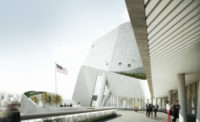
The long-running saga over Paul Rudolph’s Orange County Government Center—which officials have been threatening to demolish for more than a decade—took perhaps its strangest turn last week: Gene Kaufman, an architect best known for designing colorful towers for national hotel chains on the West Side of Manhattan, offered to buy the building.
At a meeting of the County Legislature on May 1, Kaufman offered to purchase the Rudolph building, which has been closed since 2011, and convert it to private use, perhaps as artists’ studios. In a letter to the legislature, he said he would add the building “to the tax roles (sic).” But there’s a condition: Kaufman, who bought Gwathmey Siegel & Associates in 2011, two years after the death of founder Charles Gwathmey, and now calls his firm Gwathmey Siegel Kaufman & Associates Architects, wants to design a new government building adjacent to the Rudolph masterpiece, completed in 1970 on Main Street in Goshen, New York.
Nancy Hull Kearing, founder of the Taxpayers of Orange County, an advocacy group trying to save the building, says that she is “very enthusiastic” about Kaufman’s offer. “Of course I’ve heard of Gwathmey Siegel.” In an email, she asked supporters to write to the county executive, Steven M. Neuhaus, urging him “to make an offer to Mr. Kaufman.” Kearing, a painter, was particularly intrigued by the possibility of moving artists into the building. “Those familiar with SOHO in NYC and Brooklyn,” she wrote, “know that when artists move in to a community things begin to boom and blossom.”
But just last week, the County Legislature voted 18-3 in favor of a plan to restore much of the building to its former use, though the proposal would also entail demolishing part of the building and tacking on 61,000 new square feet. The plan is the work of designLAB Architects, the Boston firm that performed similarly invasive surgery on parts of Rudolph’s University of Massachusetts campus in South Dartmouth, Massachusetts. “We don’t support the demolition,” says Kearing. “Selling the building," she added, "is preferable."
The designLAB project is budgeted at $74 million, including design fees. Kaufman, in his letter, offered to design the new building “for substantially less…creating significant savings that would accrue to the county and its budget.” (Kaufman said fees for the designLAB project would be $12.9 million; designLAB founder Robert Miklos says they would be considerably lower.) "Architects should give their unqualified support to saving this architectural masterwork," Kaufman wrote in an email. "It is a remarkably unified design of three interconnected wings surrounding a courtyard that will be irreparably damaged by demolishing the central third of it. Instead, we propose to save the entire building and restore it.”
Sean Khorsandi, co-director of the Paul Rudolph Foundation, says his organization opposes the designLAB plan, given that it will entail extensive changes to the Rudolph building. The legislature, he says, has never considered full reuse of the building. But he says he doesn’t see the Kaufman plan gaining traction, given the impracticality of building a new Government Center—as well as necessary parking for both the new and old buildings—on the site.
Miklos says his firm’s plan for the Government Center was “the best compromise that could be brokered between those who wanted to tear it down completely and those who wanted to renovate it completely.” He adds that the Kaufman plan is “entirely unlikely,” given that his proposal has already been funded by the county.
Kaufman’s letter identifies Gwathmey Siegel Kaufman & Associates as the winner of the AIA Firm Award (which was won by Gwathmey Siegel in 1982). Similarly, it credits the firm with designing an additon to Rudolph’s Art & Architecture Building at Yale. But that renovation was completed in 2008, before Kaufman bought Gwathmey Siegel, and was widely criticized for competing with Rudolph’s masterwork.


